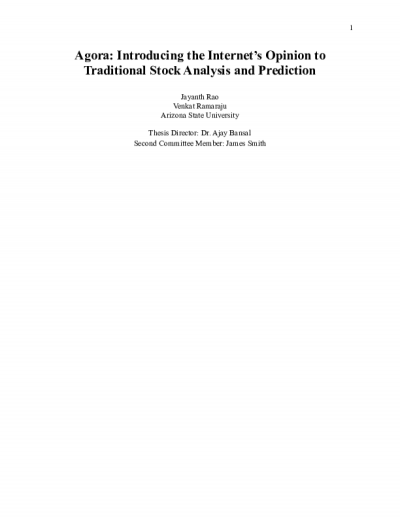Filtering by
- All Subjects: Sentiment Analysis
- Creators: Bansal, Ajay
- Creators: Nakamura, Mutsumi

To facilitate rapid, correct, efficient, and intuitive development of graph based solutions we propose a new programming language construct - the search statement. Given a supra-root node, a procedure which determines the children of a given parent node, and optional definitions of the fail-fast acceptance or rejection of a solution, the search statement can conduct a search over any graph or network. Structurally, this statement is modelled after the common switch statement and is put into a largely imperative/procedural context to allow for immediate and intuitive development by most programmers. The Go programming language has been used as a foundation and proof-of-concept of the search statement. A Go compiler is provided which implements this construct.

This project aims to incorporate the aspect of sentiment analysis into traditional stock analysis to enhance stock rating predictions by applying a reliance on the opinion of various stocks from the Internet. Headlines from eight major news publications and conversations from Yahoo! Finance’s “Conversations” feature were parsed through the Valence Aware Dictionary for Sentiment Reasoning (VADER) natural language processing package to determine numerical polarities which represented positivity or negativity for a given stock ticker. These generated polarities were paired with stock metrics typically observed by stock analysts as the feature set for a Logistic Regression machine learning model. The model was trained on roughly 1500 major stocks to determine a binary classification between a “Buy” or “Not Buy” rating for each stock, and the results of the model were inserted into the back-end of the Agora Web UI which emulates search engine behavior specifically for stocks found in NYSE and NASDAQ. The model reported an accuracy of 82.5% and for most major stocks, the model’s prediction correlated with stock analysts’ ratings. Given the volatility of the stock market and the propensity for hive-mind behavior in online forums, the performance of the Logistic Regression model would benefit from incorporating historical stock data and more sources of opinion to balance any subjectivity in the model.

This project aims to incorporate the aspect of sentiment analysis into traditional stock analysis to enhance stock rating predictions by applying a reliance on the opinion of various stocks from the Internet. Headlines from eight major news publications and conversations from Yahoo! Finance’s “Conversations” feature were parsed through the Valence Aware Dictionary for Sentiment Reasoning (VADER) natural language processing package to determine numerical polarities which represented positivity or negativity for a given stock ticker. These generated polarities were paired with stock metrics typically observed by stock analysts as the feature set for a Logistic Regression machine learning model. The model was trained on roughly 1500 major stocks to determine a binary classification between a “Buy” or “Not Buy” rating for each stock, and the results of the model were inserted into the back-end of the Agora Web UI which emulates search engine behavior specifically for stocks found in NYSE and NASDAQ. The model reported an accuracy of 82.5% and for most major stocks, the model’s prediction correlated with stock analysts’ ratings. Given the volatility of the stock market and the propensity for hive-mind behavior in online forums, the performance of the Logistic Regression model would benefit from incorporating historical stock data and more sources of opinion to balance any subjectivity in the model.

Since it doesn’t hurt to attempt to utilize feature extracted values to improve a model (if things don’t work out, one can always use their original features), the question may arise: how could the results of feature extraction on values such as sentiment affect a model’s ability to predict the movement of the stock market? This paper attempts to shine some light on to what the answer could be by deriving TextBlob sentiment values from Twitter data, and using Granger Causality Tests and logistic and linear regression to test if there exist a correlation or causation between the stock market and features extracted from public sentiment.

The e-commerce market utilizes information to target customers and drive business. More and more online services have become available, allowing consumers to make purchases and interact with an online system. For example, Amazon is one of the largest Internet-based retail companies. As people shop through this website, Amazon gathers huge amounts of data on its customers from personal information to shopping history to viewing history. After purchasing a product, the customer may leave reviews and give a rating based on their experience. Performing analytics on all of this data can provide insights into making more informed business and marketing decisions that can lead to business growth and also improve the customer experience.
For this thesis, I have trained binary classification models on a publicly available product review dataset from Amazon to predict whether a review has a positive or negative sentiment. The sentiment analysis process includes analyzing and encoding the human language, then extracting the sentiment from the resulting values. In the business world, sentiment analysis provides value by revealing insights into customer opinions and their behaviors. In this thesis, I will explain how to perform a sentiment analysis and analyze several different machine learning models. The algorithms for which I compared the results are KNN, Logistic Regression, Decision Trees, Random Forest, Naïve Bayes, Linear Support Vector Machines, and Support Vector Machines with an RBF kernel.